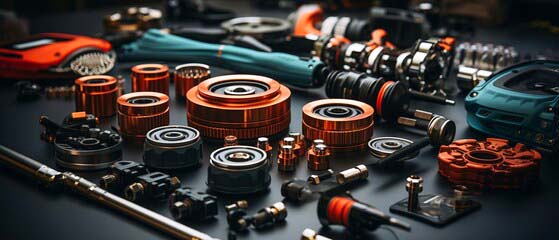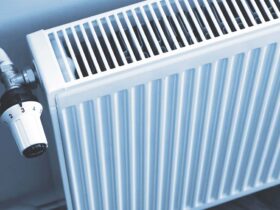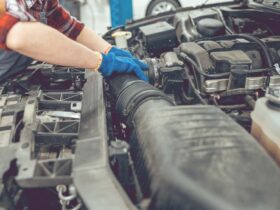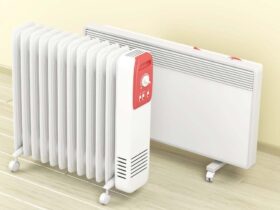The parts of a tire include the tread, sidewall, and bead. These components work together to provide traction and support for the vehicle.
Tires are an integral part of any vehicle, providing a crucial connection between the vehicle and the road. Understanding the parts of a tire is essential for proper maintenance and performance. The tread, located on the outer surface, provides traction and grip.
The sidewall is the area between the tread and the inner bead, offering flexibility and impact resistance. The bead is the inner edge of the tire, securely anchoring it to the wheel rim. Each part plays a vital role in ensuring safe and efficient operation of the vehicle. This article will explore the functions and importance of each tire component, highlighting their impact on overall vehicle performance and safety. Understanding the anatomy of a tire can help drivers make informed decisions regarding tire selection, maintenance, and performance.
Tread
Types Of Tread Patterns
When discussing the parts of a tire, the tread is an essential element. It is the part of the tire that makes direct contact with the road surface, providing traction and grip. Tread patterns play a crucial role in determining a tire’s performance in various road conditions. There are different types of tread patterns designed to cater to specific needs such as all-season, mud-terrain, and highway driving.
Tread Depth And Wear Indicator
Tread depth is a critical aspect of tire maintenance. It directly influences the tire’s capability to disperse water and maintain traction. The tread depth indicator, often in the form of small notches within the tread grooves, helps in identifying when tires have worn beyond the safe limit. Regular inspection of tread depth and wear indicators is crucial for ensuring optimal tire performance and safety on the road.

Sidewall
The sidewall of a tire is an essential part of its structure, providing crucial support and flexibility. Understanding its function and composition is crucial for maintaining and selecting the right tires for your vehicle.
Function Of The Sidewall
The sidewall of a tire serves as the link between the tread and the bead, offering crucial support to the tire’s structure. It plays a vital role in maintaining the tire’s shape, providing resistance against external forces, and offering flexibility to absorb impacts.
Composition And Design
The sidewall is typically constructed using layers of rubber, fabric, and other composite materials. This composition ensures durability and flexibility, allowing the tire to effectively absorb shocks and maintain its structural integrity. Additionally, the sidewall features various design elements such as sidewall lettering, which provides essential information about the tire’s specifications and characteristics.
Bead
In the world of tires, the bead is an often-overlooked but essential component. It plays a crucial role in keeping the tire securely attached to the rim and maintaining proper inflation. Let’s explore the role of the bead and delve into its components and construction.
Role Of The Bead
The primary role of the bead is to provide a seal between the tire and the rim, ensuring that the tire stays firmly in place. It acts as an anchor, ensuring stability and preventing the tire from slipping off the rim during acceleration, braking, or cornering.
Additionally, the bead is responsible for transmitting forces between the tire and the rim. It withstands the immense pressure generated during driving and helps maintain the tire’s shape and integrity.

Components And Construction
The bead consists of several key components that work together to provide strength and flexibility. These include:
- Outer Bead Bundle: The outer bead bundle is made up of multiple steel wires, which are encased in rubber. This layer enhances the bead’s strength and also helps to distribute forces evenly.
- Inrubber Bead Cushion: The inrubber bead cushion is a layer of rubber located on the inner side of the bead. It acts as a cushion, absorbing vibrations and reducing wear caused by friction between the tire and the rim.
- Bead Filler: Situated between the outer bead bundle and the inrubber bead cushion, the bead filler provides additional reinforcement to the bead. It enhances stability and ensures a secure fit between the tire and the rim.
The construction of the bead involves precise engineering to create a strong bond between the tire and the rim. The layers of rubber and steel wires are carefully assembled, ensuring that the bead can withstand the immense forces it will encounter during use.
It is important to note that the design and construction of the bead may vary depending on the type of tire, such as passenger, truck, or off-road tires. Manufacturers take into consideration various factors, including load requirements, performance characteristics, and specific application needs.
The bead is a critical component that contributes to the overall performance, safety, and longevity of a tire. Understanding its role and construction can help us appreciate the engineering behind this seemingly simple yet important part.
Inner Liner
The inner liner is an essential component of a tire that plays a crucial role in maintaining its structure and integrity. It is the layer that lies directly beneath the tire tread and is located on the innermost side of the tire. The inner liner is typically made of specialized rubber compounds that are specifically designed to prevent air from escaping the tire.
Purpose Of The Inner Liner
The main purpose of the inner liner is to provide a barrier that prevents air molecules from permeating through the tire structure. By ensuring that air is contained within the tire, the inner liner helps maintain proper tire pressure and ensures optimal performance.
The inner liner helps in:
- Maintaining optimal tire pressure
- Preventing air leakage
- Enhancing tire durability
- Improving fuel efficiency
By retaining air within the tire, the inner liner prevents the tire from going flat and minimizes the risk of blowouts. This not only ensures a safer driving experience but also extends the overall lifespan of the tire.

Materials Used
The materials used for the inner liner differ from those used in other parts of the tire. It is typically made of a thin layer of specialized rubber compounds that exhibit excellent air barrier properties. These rubber compounds are reinforced with materials such as synthetic fabrics or cords to enhance their strength and durability.
The inner liner is specifically formulated to be impermeable to air and resistant to temperature changes, ensuring that the tire maintains its optimal pressure across various driving conditions.
Belt Package
The belt package is an essential part of a tire, providing strength and stability. It consists of steel or fabric belts that reinforce the tire’s structure, enhancing its durability and performance. This component plays a crucial role in maintaining the tire’s shape and preventing excessive wear.
The belt package is a crucial component of a tire. It plays a significant role in the tire’s overall structure and performance. The belt package consists of multiple layers made of various materials that are strategically positioned beneath the tire’s tread. These layers help the tire withstand external forces, provide stability, and enhance its overall durability.
Importance Of The Belt Package
The belt package is vital for the tire’s performance and safety. It helps improve the tire’s resistance to punctures and impacts from road hazards. By providing extra strength and rigidity, the belt package enhances the tire’s ability to handle various driving conditions, such as high speeds and rough terrains.
Layers And Materials
The belt package comprises several layers, usually made of steel, fiberglass, or polyester cords. These layers are positioned in a crisscross pattern, forming a sturdy structure that reinforces the tire’s tread area. The number of layers and the type of materials used can vary depending on the tire’s intended purpose and performance characteristics. When it comes to high-performance tires, the belt package may include steel belts for added strength and responsiveness.
On the other hand, passenger tires often feature two or more layers of polyester or fiberglass cords, which offer a balance of durability and ride comfort. In addition to the layers, the belt package also includes a protective layer known as a cap ply. This layer, typically made of polyester, enhances the tire’s overall strength, helps distribute the stress evenly across the tire’s surface, and improves its resistance to heat buildup.
Overall, the belt package is a critical component that contributes to the tire’s stability, durability, and performance. Its careful design and selection of materials ensure a safe and reliable driving experience. Whether you’re navigating city streets or tackling off-road adventures, a well-constructed belt package is essential for optimal tire performance.

Carcass
In the world of tires, the carcass plays a crucial role in providing strength, durability, and structural integrity. Serving as the foundation, the carcass is located between the tread and the inner liner, and it consists of multiple layers of fabric cord. Let’s dive deeper into the function of the carcass and explore the different ply ratings and types.
Function Of The Carcass
The carcass of a tire is responsible for giving it the necessary strength and shape. It acts as a supporting framework that holds the shape of the tire and withstands the pressure from the inflation. Comprised of layers of fabric cords commonly made of steel or polyester, the carcass provides stability, allowing for proper handling and maneuverability of the vehicle. Additionally, it ensures optimal tread contact with the road surface, promoting traction and grip.
Ply Rating And Types
In the tire industry, the term “ply rating” refers to the number of layers of fabric cord used in the carcass construction. The higher the ply rating, the stronger the tire. However, it is important to note that modern tires no longer use actual plies, but the term is still used as a measure of strength.
There are three common types of carcass construction:
- Bias Ply: In this construction, the fabric cords run diagonally across the tire, forming a crisscross pattern. Bias ply tires provide excellent load-carrying capacity and are commonly used in heavy-duty applications.
- Radial Ply: Unlike bias ply tires, radial ply tires have their fabric cords running perpendicular to the direction of travel. This design offers better heat dissipation and improved fuel efficiency. Radial ply tires are the most common type of tires used in modern vehicles.
- Bias Belted: As the name suggests, this type of carcass construction combines elements of both bias ply and radial ply tires. It features additional belts made of steel or other materials positioned under the tread, enhancing stability and tread life.
Understanding the function and types of the carcass allows you to make informed choices when it comes to selecting tires for your vehicle. Remember to consider factors such as load capacity, handling requirements, and road conditions to ensure the optimum performance and safety of your vehicle.
Casing
The casing is a crucial component of a tire, serving as the framework that supports the tire and influences its performance. It is the foundation on which the tread and sidewall are built, and it plays a significant role in determining the tire’s strength, durability, and overall handling characteristics.
Significance Of The Casing
The casing of a tire is of paramount importance as it contributes to the tire’s structural integrity and stability. It serves as the framework for the tread and sidewall, helping the tire maintain its shape and withstand various road conditions and forces.
Radial Vs. Bias-ply Casings
Radial and bias-ply casings are two primary types of tire constructions, each with distinct characteristics that impact the tire’s performance. Radial casings have plies that run radially across the tire, providing excellent flexibility and a smooth ride, while bias-ply casings have plies that crisscross at an angle, offering enhanced strength and stability.

Frequently Asked Questions Of Parts Of A Tire
What Are The Parts Of The Tire?
The main parts of a tire include the tread, sidewall, bead, belts, and carcass. The tread is the part that makes contact with the road. The sidewall provides stability and protection. The bead ensures the tire stays on the wheel rim.
Belts strengthen the tire and improve handling. The carcass holds everything together.
What Is The Air Thing On A Tire Called?
The air thing on a tire is called a valve stem. It allows you to add or release air from the tire.
What Are The Metal Things On Tires Called?
The metal things on tires are called tire studs. They are used for better traction on icy or snowy roads.
Conclusion
Understanding the different parts of a tire is essential for maintaining and maximizing its performance. From the tread to the sidewall and bead, each component plays a crucial role in providing traction, stability, and durability. By knowing these parts and ensuring proper maintenance, you can enhance the safety and longevity of your tires.
So, take the time to familiarize yourself with these components and give your tires the attention they deserve. Bookmark this guide for future reference and confidently navigate the world of tires!





